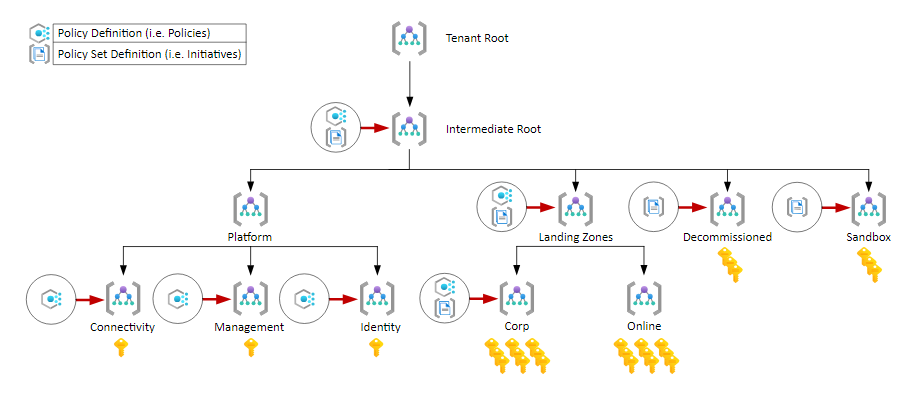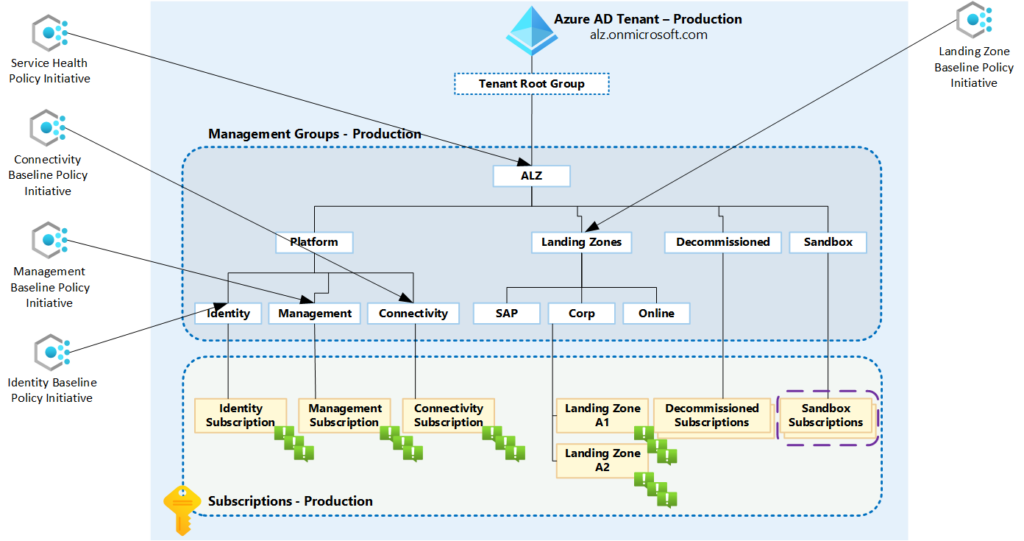Welcome to the blog series:
Exploring Microsoft Azure Landing Zone Best Practices.
In this series, we will dive deep into the concept of the Azure Landing Zone and explore the best practices that organizations can follow to design, implement, and manage their Azure estate effectively.
Whether you are new to Azure or already have an existing Azure environment, this series will provide valuable insights and guidance to optimize your cloud journey using Azure Landing Zone.
Chapter 1: Understanding Azure Landing Zone
- Introduction: What is the Azure Landing Zone?
- Benefits of the Azure Landing Zone for organizations
- Key components of the Azure Landing Zone
What is the Azure Landing Zone?
When you refer to an Azure Landing Zone, you are describing the cloud environment which contains not only specific infrastructure, but also the various management, subscription, identity and security components which govern this environment.
In today’s digital landscape, organizations are increasingly turning to the cloud to scale their operations efficiently and as such, are left with the responsibility to ensure their digital estate conforms to supported architectures. Microsoft Azure offers a comprehensive suite of services and solutions to help organizations embark on their cloud journey.
One essential concept within Azure is the Azure Landing Zone, which serves as a critical foundation for building a robust and well-architected cloud infrastructure.
In this article, we will explore the benefits of Azure Landing Zone for organizations and delve into its key components.
Azure Enterprise Landing Zone Architecture, Source: Azure landing zone architecture by Microsoft
Benefits of the Azure Landing Zone for Orginizations
If we consider that each organization is fundamentally different, one can assume that these differences would also apply when looking closely at the ways in which their cloud adoption journeys have played out. As someone who has worked with organizations across the globe, some of these design principles and their deviations from a common architectural pattern can often be easily be observed.
What then can be said of the benefits in adopting the Azure Landing Zone?
I have summarised these benefits in to 3 distinct catagories:
1. Scalability and Agility:
An Enterprise Azure Landing Zone allows organizations to design and implement their cloud infrastructure with scalability in mind.
With the ability to create multiple subscriptions and management groups, organizations can efficiently manage resources while scaling their infrastructure as needed. This flexibility enables organizations to adapt to fluctuating workloads and dynamic business requirements swiftly.
Policy Definition Structure. Source: Policies included in Azure landing zones reference implementations, by ALZ
2. Enhanced Security and Compliance:
A well designed Azure Landing Zone incorporates security best practices by implementing various built-in Azure security features.
Organizations can leverage Azure Security Center to monitor and protect their resources from threats, apply strict identity and access management with Azure Active Directory (Azure AD), and ensure data encryption using Azure Key Vault. Compliance standards like GDPR, HIPAA, or ISO can also be met by configuring Azure policies and governance frameworks within the Landing Zone.
Below is a great repository for deploying Azure MonitorAlerts for your Landing Zone:
Alerts for Azure Landing Zone using Azure Monitor
3. Improved Cost Optimization and Management:
The Azure Landing Zone empowers organizations to exercise cost optimization techniques effectively.
With proper resource grouping and tagging within subscriptions, teams gain visibility into their cloud expenditure and can optimize their utilization. Azure Cost Management and Billing offer detailed reports, budget alerts, and recommendations to optimize spending on Azure resources, ensuring overall cost efficiency.
Key Components of The Azure Landing Zone
1. Azure Resource Hierarchy:
The Azure Resource Hierarchy provides a logical structuring of resources, allowing efficient management and governance.
At the top level, organizations can deploy Azure Management Groups to group related subscriptions. Within each subscription, Resource Groups are created to group resources based on business functions or projects. This hierarchy enables better resource organization and access control.
Source, management group hierarchy with Azure policy
2. Azure Policy and Governance:
Azure Landing Zone emphasizes governance by using Azure Policy. These policies help organizations enforce compliance rules, define best practices, and control resource configurations across subscriptions. Azure Blueprints can also be utilized within the Landing Zone to automate the deployment of custom templates and resource configurations, ensuring consistency and adherence to organizational standards.
Source: Management Group hierarchy with Azure policies Applied
3. Network Topology and Connectivity:
Designing a robust network topology is crucial within an Azure Landing Zone. Organizations can create virtual networks (VNets) to connect resources, subnets to segment workloads, and network security groups (NSGs) to control inbound and outbound traffic. Connectivity options like Virtual Private Networks (VPNs), ExpressRoute, or peering with other VNets enable secure and scalable communication between on-premises networks and Azure resources.
Secure Hub and Spoke with forced network tunneling
A great repository for network designs for landing zones in Azure: Hub And Spoke With A Flat Network And Forced Tunneling
4. Identity and Access Management:
Azure Landing Zone leverages Azure AD to manage user identities, access control, and authentication mechanisms. This component plays a crucial role in securing resources, ensuring proper role-based access control (RBAC), and implementing multi-factor authentication (MFA). Organizations can integrate Azure AD with existing on-premises Active Directory environments, providing a seamless and secure user experience.
Conclusion
Understanding the benefits and key components of Azure Landing Zone is vital for organizations embarking on their Azure cloud journey.
By implementing Azure Landing Zone best practices, organizations can build a scalable, secure, and well-governed cloud infrastructure that optimizes costs and meets compliance requirements. With Azure Landing Zone serving as a solid foundation, organizations can harness the full potential of Microsoft Azure, accelerating their digital transformation and gaining a competitive edge in the evolving business landscape.
Join me for Chapter 2, where we will be unpacking more details around planning your Azure Landing Zone strategy:
Chapter 2: Planning Your Azure Landing Zone
- Introduction: Importance of proper planning
- Assessing organizational requirements and goals
- Understanding Azure Resource Hierarchy and Role-Based Access Control (RBAC)
- Defining deployment regions and networking considerations
- Azure Policies, Blueprints, and Governance frameworks
Thanks for reading!








